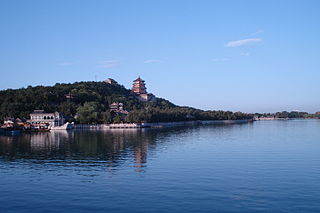
The Summer Palace is a vast ensemble of lakes, gardens and palaces in Beijing. It was an imperial garden in the Qing dynasty. Inside includes Longevity Hill Kunming Lake and Seventeen Hole Bridge. It covers an expanse of 2.9 square kilometres (1.1 sq mi), three-quarters of which is water.
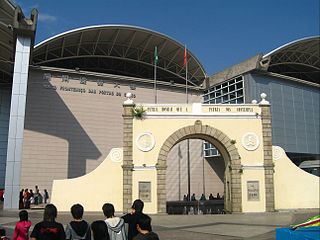
Nossa Senhora de Fátima is the northernmost and largest civil parish in the Macau Peninsula of Macau. It has an area of 3.2 square kilometers (1.2 sq mi) and a population of 126,000, which constitutes about 40.3% of the peninsula's land mass and one-third of the population.

São Lázaro is the smallest civil parish of Macau, located in the central-east region of the Macau Peninsula. It is surrounded by the parishes of Nossa Senhora de Fátima, Santo António, and Sé.

Yilan City is a county-administered city and the county seat of Yilan County, Taiwan Province, Republic of China. The city lies on the north side of the Lanyang River.
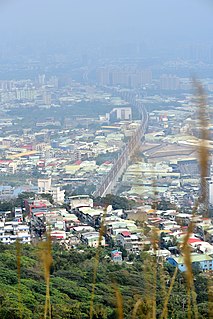
Shulin District is an inner city district in southwestern New Taipei City, Taiwan.

Taihoku Prefecture was an administrative division of Taiwan created in 1920, during Japanese rule. The prefecture consisted of modern-day Keelung, New Taipei City, Taipei and Yilan County. Its government office, which is now occupied by the Control Yuan of Taiwan, was in Taihoku City.
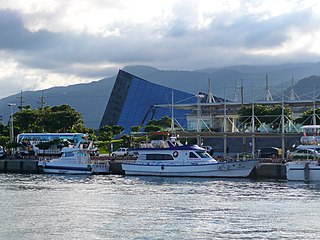
Toucheng Township is an urban township in Yilan County, Taiwan. The township includes Guishan Island and Guiluan Island in the Philippine Sea. The Senkaku Islands, known in Mandarin as the Diaoyu Islands, are claimed as part of the township.
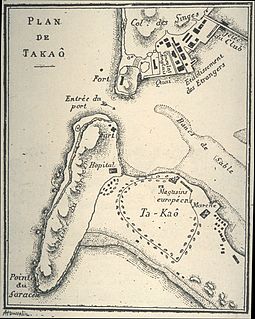
The written history of Kaohsiung can be traced back to the early 17th century, though archeological studies have found signs of human activity in the region from as long as 7000 years ago. Prior to the 17th century, the region was inhabited by the Makatau clan of the Siraya aboriginal tribe, who settled on what they named Ta-kau Isle ; "Takau" meaning "bamboo forest" in the aboriginal language. Dutch settlers colonizing Taiwan in 1624 referred to the region as Tankoya and named the harbor Tancoia. The first Chinese records of the region were written in 1603 by Chen Di, a member of Ming admiral Shen You-rong's expedition to rid the waters around Taiwan and Penghu of pirates. In his report on the "Eastern Barbarian Lands", Chen Di referred to a Ta-kau Isle:
It is unknown when the barbarians of the Eastern Lands arose on this island in the ocean beyond Penghu, but they are present at 起魍港, 加老灣, 歷大員, 堯港, Ta-kau Isle, 小淡水, 雙溪口, 加哩林, 沙巴里, and 大幫坑.
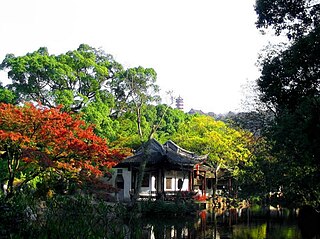
Jichang Garden is located inside Xihui Park, east side of Huishan, east side of western suburban of Wuxi, Jiangsu Province, China. It is close to Huishan Temple. Jichang Garden is a famed Chinese classical garden in South China, and it was claimed as a national protected location of historical and cultural relics on 13 January 1988. Xiequ Garden (谐趣园) inside the Summer Palace and Guo Ran Da Gong (廓然大公) in Yuanming Yuan in Beijing both imitated Jichang Garden.
The Taiyuan Basin is located around the southern tail of the Hai'an Range in eastern Taiwan. The entire basin is located in the Dunghe Township of Taitung County. It is the traditional territory of the indigenous Amis. There is an archaeological site named Taiyuan site (泰源遺址) in the basin, which is a part of the Cilin Culture (麒麟文化).
The Niaosung Culture was an archaeological culture in southern Taiwan. It distributed around the region of Tainan and Kaohsiung. The culture existed in the Iron Age of Taiwan island. Some evidences suggested that Niaosung Culture was directly relative to the Siraya people, an aboriginal tribe which is still living in this area.
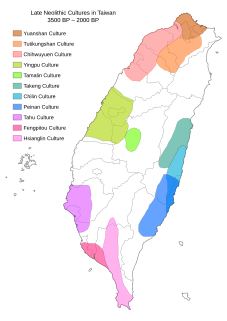
The Tahu Culture was an archaeological culture in southern Taiwan. It distributed around the Tainan-Kaohsiung region. The culture was one of the late Neolithic cultures of Taiwan island. A set of several archaeological sites formed the culture, such as the Tahu Site (大湖遺址), Fengpitou Site (鳳鼻頭遺址) and Wushantou Site (烏山頭遺址). These sites had been excavated out many bone tools, potteries or middens.

The Dulan Site is an archaeological site in Dulan Village, Donghe Township, Taitung County, Taiwan.
Fanchengdui culture is an archaeological culture discovered in 1970, in the town of Zhuwei, Qingjiang county, Jiangxi province, China, in archaeological sites such as Fanchengdui. It is a distinctive type of Chalcolithic to Bronze Age culture.
Liye is a town of Longshan County, Hunan Province, China. Located on the northern bank of You River, Liye is the southernmost town of the county, and bordered to the west by Youshuihe Town and Keda Township of Youyang County, Daxi Township of Xiushan County of Chongqing Municipality, to the south by Qingshuiping and Bier Towns of Baojing County, to the east and southeast by Maoertan Town, to the southwest by Zaguo Township. The present-day Liye was reformed on November 30, 2015. It covers an area of 259.2 square kilometres (100.1 sq mi), as of November, 2015, it has a registered population of 43,300, the seat is Liye Community.
The architecture of Taiwan can be traced back to stilt housing of the aborigines in prehistoric times; to the building of fortresses and churches in the north and south used to colonize and convert the inhabitants during the Dutch and Spanish period; the Tungning period when Taiwan was a base of anti-Qing sentiment and Minnan-style architecture was introduced; in Qing dynasty period, a mix of Chinese and Western architecture appeared and artillery battery flourished during Qing's Self-Strengthening Movement; During the Japanese rule of Taiwan, the Minnan, Japanese and Western culture were main influencers in architectural designs and saw the introduction and use of reinforced concrete. Due to excessive Westernization as a colony, after the retrocession of Taiwan to the Republic of China in 1945 from Japan at the end of World War II, Chinese classical style became popular and entered into international mainstream as a postmodern design style. Today, Taiwanese architecture has undergone much diversification, every style of architecture can be seen.

The Sichuan anti-Mongol fortresses are 83 mountain cities built by the soldiers and civilians of the Southern Song Dynasty during the Mongol conquest of China in Sichuan to resist the invasion of the Mongol Empire. Taking full advantage of the geographical advantages of the Sichuan Basin, these fortresses formed a comprehensive three-dimensional defense system, which succeeded in resisting the Mongol attacks for up to 53 years, greatly extending the life of Southern Song. They also made Sichuan the last to be conquered by the Mongolians in 1288. Due to the defense of the fortresses, it was difficult to settle the Sichuan region. The Mongol Army had to abort its original strategy of "taking Shu (Sichuan) and destroying Song" and moved to the area of Jingzhou and Xiangyang starting from 1271, defeating the Song Dynasty via the Han River. Möngke Khan became the only Mongol khagan to perish on the battlefield when he died during an assault on Diaoyucheng in 1259. He may have been a victim of dysentery or of injuries sustained when attacking the fortress.













